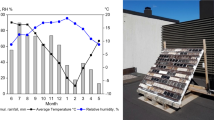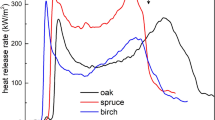Summary
The exposure of wood treated with a commercial fire retardant chemical to fire conditions resulted in different patterns of char and fissure development than are seen in untreated whole wood. In addition microstructural observations demonstrated the existence of particulate fire retardant residues in char from treated wood. The source and mode of growth of these particles is considered as well as effects of fire retardants on crack growth, char development and overall appearance of chars from treated wood.
Similar content being viewed by others
References
Beaumont, P. W. R. 1974: A fracture mechanics approach to failure in fibrous composites. J. Adhes. 6: 107–137
Broido, A.; Kilzner, F. J. 1963: A critique of the present state of knowledge for the mechanism of cellulose pyrolysis. Fire Res. Abstr. and Rev. 5 (2): 157
Broido, A.; Javier-son, A. C.; Ouano, A. C.; Barrall, E. M., III. 1973: Molecular weight decreases in the early pyrolysis of crystalline and amorphous cellulose. J. Appl. Poly. Sci., 12 (36): 27–35
Broido, A. 1975: (Pacific Southwest Forest and Range Experiment Station, USDA Forest Service, Berkeley, CA). Personal communication
Broido, A.; Nelson, M. A. 1975: Char yields on pyrolysis of cellulose. Combind. Flame 24: 263–280
Eickner, H. W.; Stinson, J.; Jordan, J. 1969: Ammonium polyphosphate liquid fertilizer as fire retardant for wood. Proc. Am. Wood Pres. Assoc. 65: 260–271
Gaggar, S.; Broutman, L. J. 1974: Development of a damage zone at the tip of a crack in a glass fiber reinforced polyster resin. Int'l. J. of Fracture 10: 606–608
Greaves, H. 1974. Electron probe X-ray analysis of selected anatomical features in CCA treated wood. Wood Sci. 7 (2): 164
Hess, D.; Falk, R.; Bayer, D. 1975: The influence of specimen topography on X-ray microanalysis element mapping. Am. J. Bot. 62 (3): 246–253
Knudson, R. M.; Williamson, R. B. 1971: Influence of temperature and time upon pyrolysis of untreated and fire retardant treated wood. Wood Sci. Technol. 5: 176–189
Koch, P. 1972. Utilization of the southern pines. Vol. II, (1117–1126). USDA Ag. Hdbk. No. 420 GPO, Wash., D.C.
Kusy, R. P.; Turner, D. T. 1977: Influence of molecular weight of PMMA on fracture morphology in notched tension. Polymer 18: 391
Levitt, A. P. 1970: Whisker Technology. New York: John Wiley
Mallick, P. R.; Broutman, L. J. 1975: Mechanical and fracture behavior of glass bead filled epoxy composites. Mater. Sci. Eng. 18: 63–73
Sultan, J. N.; McGarry, F. J. 1967: Toughening mechanisms in polyester resins and composites. Mat. Res. Lab., Dept. of Civ. Eng., MIT Res. Report R 67-66
Tang, W.; Neill, W. R. 1964: Effect of flame retardants on pyrolysis and combustion of α-cellulose. J. Poly. Sci. Part C. 6: 65–81
Tang, W. 1967: Effect of inorganic salts on pyrolysis of wood, α-cellulose and lignin-determined by dynamic thermogravimetry. USDA For. Prod. Lab., Madison, Wisc. Res. Paper FPL 91
Tang, W. K.; Eickner, H. W. 1968: Effect of inorganic salts on pyrolysis of wood, cellulose and lignin by D. T. A. USDA For. Prod. Lab., Madison, Wisc. Res. Paper FPL 82
Willner, A. M.; McGarry, F. J. 1966: Effects of interstitial inclusions in fiber reinforced composites. Second Quarterly Progress Report, Mat. Res. Lab., Dept. Civ. Eng., MIT
Zicherman, J. B. 1975: SEM X-ray analysis of pentachlorophenol in treated wood. Wood and Fiber 7 (2): 110–118
Zicherman, J. B. 1978: A study of wood morphology and microstructure in relation to its behavior in fire exposure. Ph. D. Dissertation, Univ. Calif., Berkeley. (Available from University microfilms, Ann Arbor, Mich. and as U.C. Berkeley Fire Res. Group Report No. 78-114)
Zicherman, J. B.; Williamson, R. B. 1981: Fire exposure of small wood specimens. Fire Technology (In press)
Author information
Authors and Affiliations
Additional information
The authors wish to acknowledge the general support of the University of California Berkeley Fire Research Group (NSF-RANN-S-22053, NFPCa-S-22584), University of California Berkeley Electron Microscopy Lab. (NSF-GB-38359) and the University of California, Davis Department of Botany (NSF-GB-29653). In addition we would also like to thank Dr. Arno P. Schniewind, University of California Forest Products Laboratory and Dr. R. Falk, University of California, Davis, Department of Botany
Rights and permissions
About this article
Cite this article
Zicherman, J.B., Williamson, R.B. Microstructure of wood char. Wood Sci. Technol. 16, 19–34 (1982). https://doi.org/10.1007/BF00351372
Received:
Issue Date:
DOI: https://doi.org/10.1007/BF00351372




